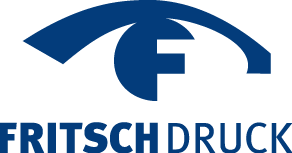UV offset printing
In its constituents and its processing of the pressure of UV offset inks the transmission of coatings is similar. In the article "UV coating" is therefore discussed in detail the principle and its effect.
Technical background
UV-reactive ink does not dry like conventional inks, but by radiation curing. The color is 100% solid and contains binders consisting of acrylate monomers and prepolymers, color pigments and photoinitiators. The latter, after irradiation with ultraviolet light, elicit a chain reaction, mono- and prepolymers react to three-dimensionally crosslinked polymers. This polymerization results in a curing of the film in fractions of seconds. Drying times before further processing are not necessary, short delivery times can be realized.
Printing machines for UV offset printing require special equipment, especially special gum cloths and cylinders as well as UV emitters in the drying facility. Offset printing machines with an additional varnishing unit or hybrid machines are used which are suitable for both conventional and UV offset printing. UV inks are also available for other conventional printing processes and for inkjet printing.
During the printing process, protective measures must be taken to prevent damage to health; ozone formed during drying is removed by means of suction devices. However, when the ink is completely cured, the printer does not endanger the end user.
Effect
The higher pigmentation of the UV ink results in a more brilliant, color-intensive print image compared to conventional offset printing. Special colors can be better interpreted in CMYK. The color impression no longer changes as a result of the drying process. The image reproduction on uncoated materials is more detailed, because the color hardly pushes into the material. The light gloss of the print image is in a pleasant contrast when printed on matte paper.
Because of the immediate curing, the ink application can be significantly higher.
The UV color is abrasion resistant, which minimizes or eliminates many quality problems (no rubbing, carbonation, chafing). It is not possible to dispense with protective lacquers (except for very high mechanical stress) so that the whiteness and haptics of the substrate are maintained.
Pressure can not be applied to pressure dusting powders. This results in additional quality advantages for subsequent workflows, such as further printing processes, foil lamination or bookbinding processing. The harsh feel of powdered prints, especially in dark pictures, is a thing of the past.
The colors have a high abrasion and solvent resistance and are very light.
Application possibilities
In general, all products which can be produced in conventional offset printing can also be realized in UV printing. In addition, non-absorbing surfaces, such as, for example, transparent paper, plastics and metal surfaces can also be printed, so that the application of the UV offset printing extends to many areas. In the packaging sector, high-quality cardboard and labels are printed with UV inks. The high mechanical stability also has a positive effect in this field of application. The UV offset printing can be combined with other refining techniques, for example with lacquering, embossing or laminating.
Limitations
In the case of highly absorbent material, a part of the ink can strike off into the substrate, which affects the gloss. This can, if necessary, be compensated for by a higher color layer thickness. Optical brighteners in the substrate can yellow due to the UV radiation. During processing, creasing, cutting or folding lines can cause color to burst because UV inks are brittle. UV inks have a specific intrinsic odor which, after curing, clearly but not completely disappears. At the moment there is also no low migration color for food packaging.
Costs
UV inks are more expensive than conventional printing inks. The printing presses must have special equipment, in addition to the UV spotlights, as well as special gum cloths and color rollers. Radiation dryers are technically complex and require high energy expenditure.
Sources and additional literature
[1] Arbeitskreis UV-Druck – eine Initiative der Berufsgenossenschaft Druck und Papierverarbeitung (Herausgeber): „UV-Technologie – Der Praxisleitfaden für alle Druckverfahren“; Berufsgenossenschaft Druck und Papierverarbeitung, Wiesbaden, 2007
[2] Kipphan, Helmut: Handbuch der Printmedien – Technologien und Produktionsverfahren; Springer-Verlag Berlin Heidelberg, 2000, Seite 140
[3] Schmitt, Jörg: UV-Offsetdruck – Märkte, Anwendungen, Technologien; Hüthig, Heidelberg, 2007
